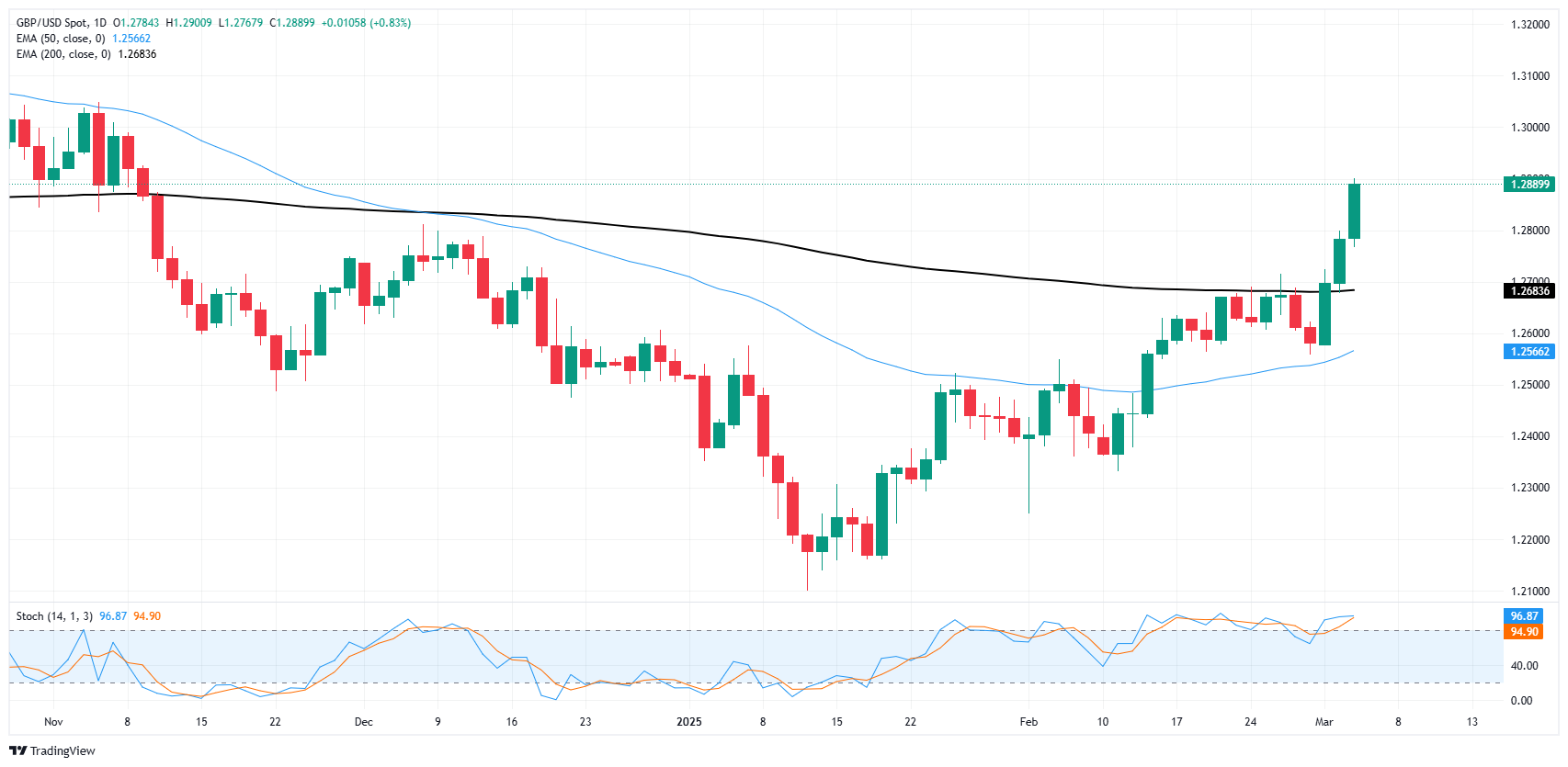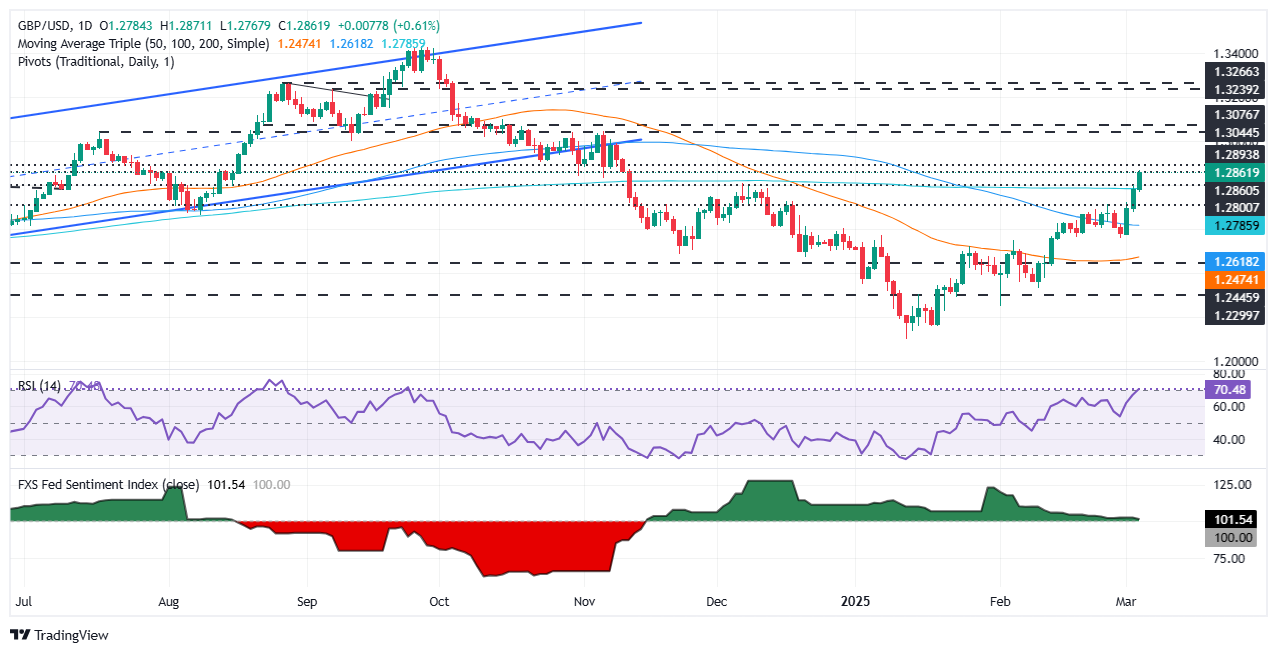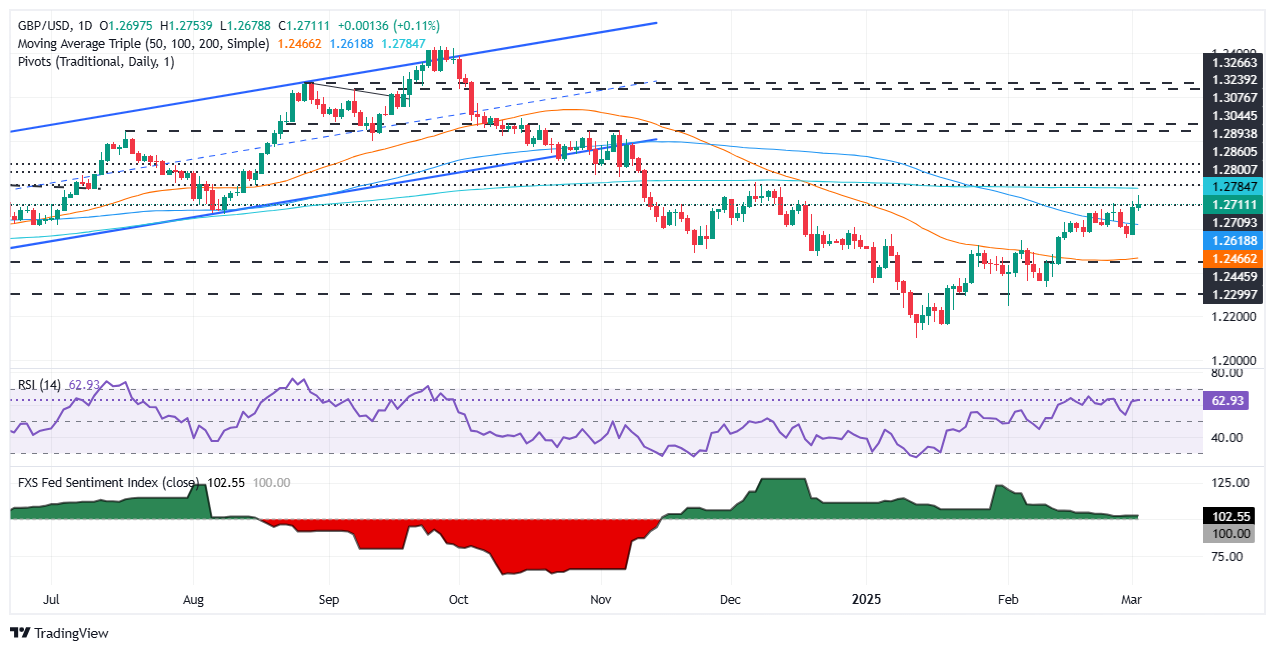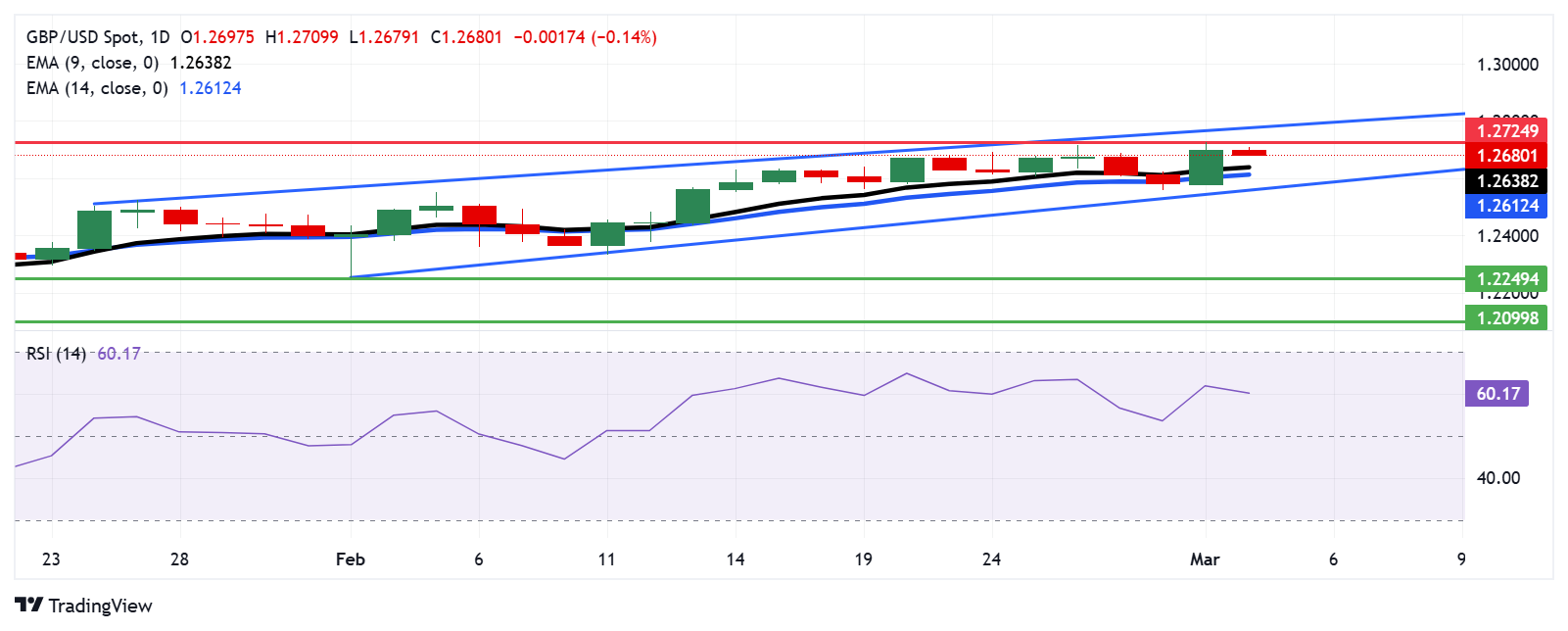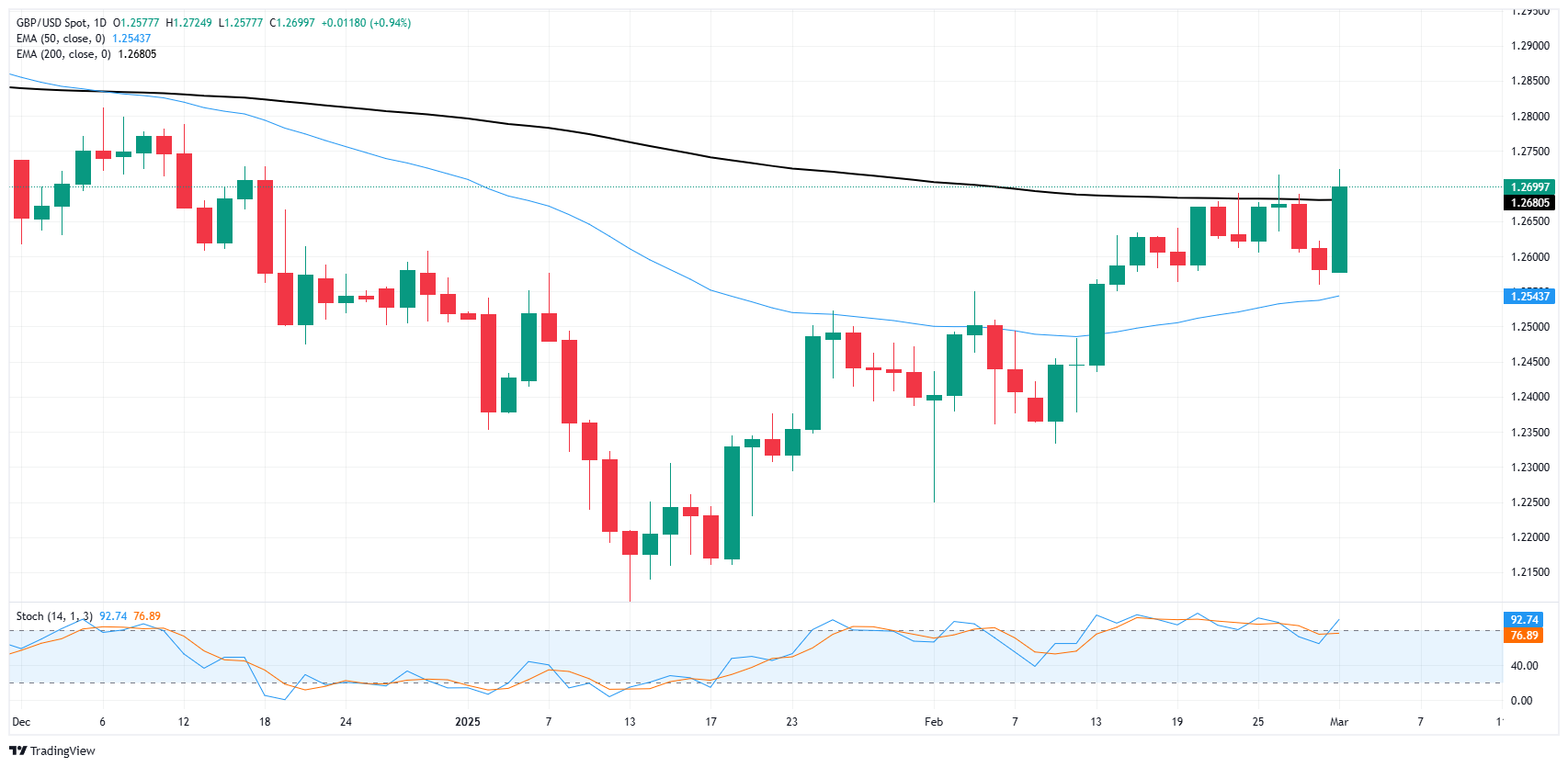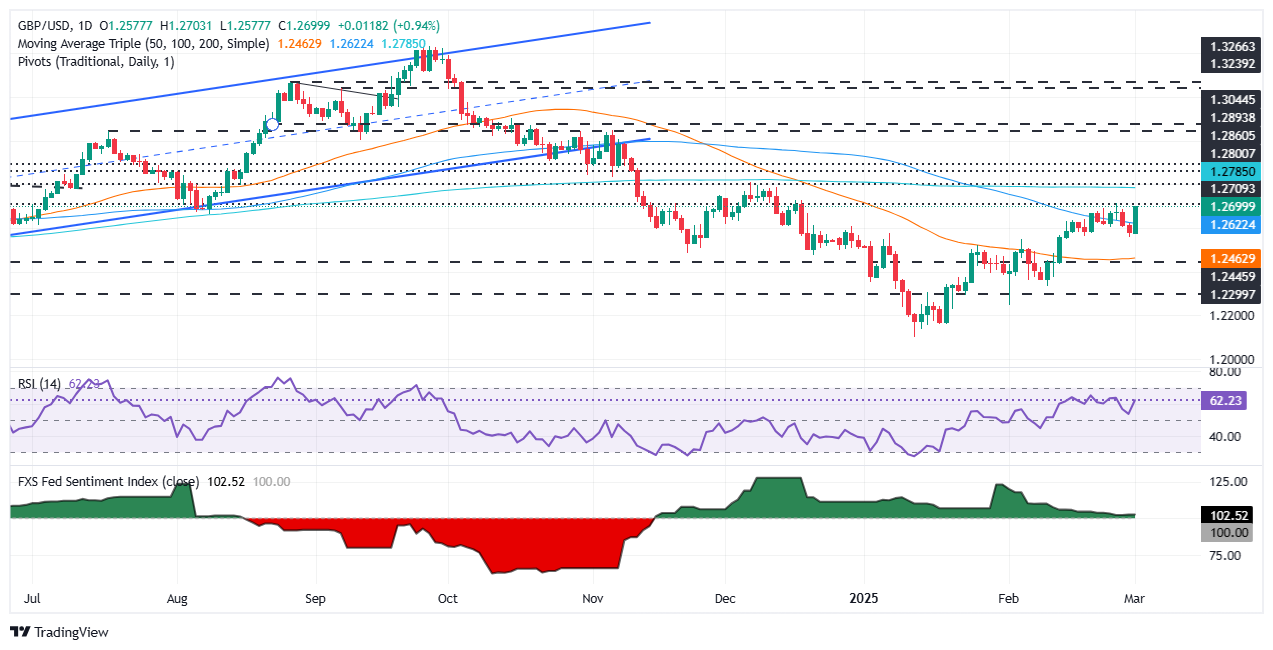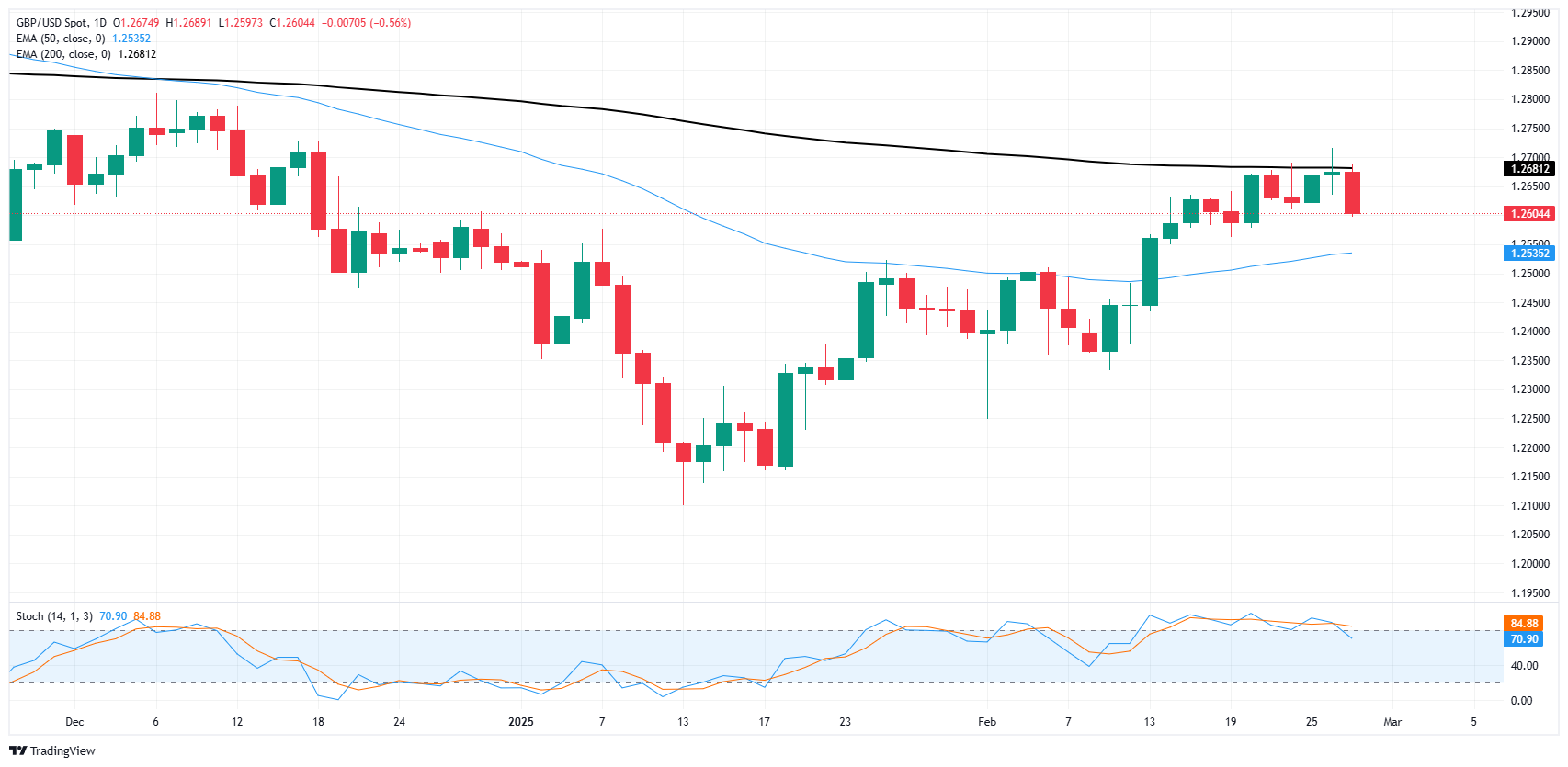- Analytics
- News and Tools
- Quotes
- Chart and quotes for GBPUSD
CFD Trading Rate Great Britain Pound vs US Dollar (GBPUSD)
| Date | Rate | Change |
|---|
Related news
-
06.03.2025 03:10GBP/USD hovers around 1.2900, upside seems possible due to risk-on sentiment
- GBP/USD may extend its gains as improved risk sentiment could support the pair.
- The US Dollar weakened after disappointing US private payroll data heightened concerns over slowing US economic growth.
- BoE Governor Bailey called on the US to resolve its global economic concerns through dialogue rather than imposing import tariffs.
GBP/USD edges lower after registering gains for the last three consecutive days, trading around 1.2890 during the Asian hours on Thursday. The US Dollar remains under pressure following weaker-than-expected US private payroll data, raising concerns about slowing economic momentum in the United States (US). Additionally, improved risk sentiment puts downward pressure on the Greenback, driven by another shift in US President Donald Trump’s tariff strategy.
The ADP Employment Change report for February showed just 77K new jobs, significantly below the 140K forecast and well under March’s 186K reading. Market participants are now focused on Friday’s US Nonfarm Payrolls (NFP) report, which is expected to indicate a moderate recovery in job growth. Forecasts suggest net job additions will rise to 160K in February, up from January’s 143K.
On Wednesday, the White House announced that Trump is temporarily exempting automakers from newly imposed 25% tariffs on Mexico and Canada for one month. Additionally, reports from Bloomberg suggest he is also considering excluding certain agricultural products from tariffs on these countries.
In the United Kingdom (UK), Bank of England (BoE) Governor Andrew Bailey urged the United States on Wednesday to address its concerns about the global economy through dialogue rather than resorting to import tariffs, which were imposed this week by US President Donald Trump, according to Reuters.
Meanwhile, while testifying before the Treasury Committee in parliament, BoE policymaker Megan Greene emphasized the importance of a cautious and gradual approach to easing monetary restrictions. Greene stated, "It's likely inflation persistence will fade on its own accord," while reiterating that monetary policy will likely need to remain restrictive.
Pound Sterling FAQs
The Pound Sterling (GBP) is the oldest currency in the world (886 AD) and the official currency of the United Kingdom. It is the fourth most traded unit for foreign exchange (FX) in the world, accounting for 12% of all transactions, averaging $630 billion a day, according to 2022 data. Its key trading pairs are GBP/USD, also known as ‘Cable’, which accounts for 11% of FX, GBP/JPY, or the ‘Dragon’ as it is known by traders (3%), and EUR/GBP (2%). The Pound Sterling is issued by the Bank of England (BoE).
The single most important factor influencing the value of the Pound Sterling is monetary policy decided by the Bank of England. The BoE bases its decisions on whether it has achieved its primary goal of “price stability” – a steady inflation rate of around 2%. Its primary tool for achieving this is the adjustment of interest rates. When inflation is too high, the BoE will try to rein it in by raising interest rates, making it more expensive for people and businesses to access credit. This is generally positive for GBP, as higher interest rates make the UK a more attractive place for global investors to park their money. When inflation falls too low it is a sign economic growth is slowing. In this scenario, the BoE will consider lowering interest rates to cheapen credit so businesses will borrow more to invest in growth-generating projects.
Data releases gauge the health of the economy and can impact the value of the Pound Sterling. Indicators such as GDP, Manufacturing and Services PMIs, and employment can all influence the direction of the GBP. A strong economy is good for Sterling. Not only does it attract more foreign investment but it may encourage the BoE to put up interest rates, which will directly strengthen GBP. Otherwise, if economic data is weak, the Pound Sterling is likely to fall.
Another significant data release for the Pound Sterling is the Trade Balance. This indicator measures the difference between what a country earns from its exports and what it spends on imports over a given period. If a country produces highly sought-after exports, its currency will benefit purely from the extra demand created from foreign buyers seeking to purchase these goods. Therefore, a positive net Trade Balance strengthens a currency and vice versa for a negative balance.
-
05.03.2025 23:32GBP/USD continues to rally, searching for 1.2900
-
05.03.2025 15:21GBP/USD surges as weak US data fuels Fed rate-cut bets
-
05.03.2025 08:35GBP/USD: The next major resistance at 1.2900 is likely out of reach – UOB Group
-
05.03.2025 05:27GBP/USD holds positive ground near 1.2800, Bailey's testimony in focus
-
04.03.2025 15:06GBP/USD holds gain amid soft US Dollar on tariff fallout
-
04.03.2025 08:41GBP/USD: Can test the major resistance at 1.2730 – UOB Group
-
04.03.2025 04:08GBP/USD Price Forecast: Hovers below 1.2700 barrier near three-month highs
-
03.03.2025 23:56GBP/USD rallies on a moment of Greenback weakness, but tensions remains high
-
03.03.2025 15:25GBPUSD rallies on soft US ISM data, falling US yields
-
03.03.2025 10:36GBP/USD: Two-week GBP strength has ended – UOB Group
-
03.03.2025 00:58GBP/USD retakes 1.2600 amid modest USD weakness; upside potential seems limited
-
03.03.2025 00:58GBP/USD retakes 1.2600 amid modest USD weakness; upside potential seems limited
-
28.02.2025 15:57GBP/USD struggles at 1.2600 set to first monthly gain since September
-
28.02.2025 10:07GBP/USD: Any decline is part of a lower 1.2570/12640 range – UOB Group
-
28.02.2025 05:50GBP/USD holds below 1.2600 as US PCE inflation data looms
-
27.02.2025 23:28GBP/USD tumbles as tariffs on UK come into play
-
27.02.2025 08:58GBP/USD: Expected to trade between 1.2640 and 1.2700 – UOB Group
-
27.02.2025 03:42GBP/USD holds losses near 1.2650 as risk aversion intensifies, US Treasury yields climb
-
26.02.2025 23:14GBP/USD runs out of bullish gas at key technical levels
© 2000-2025. All rights reserved.
This site is managed by Teletrade D.J. LLC 2351 LLC 2022 (Euro House, Richmond Hill Road, Kingstown, VC0100, St. Vincent and the Grenadines).
The information on this website is for informational purposes only and does not constitute any investment advice.
The company does not serve or provide services to customers who are residents of the US, Canada, Iran, The Democratic People's Republic of Korea, Yemen and FATF blacklisted countries.
Making transactions on financial markets with marginal financial instruments opens up wide possibilities and allows investors who are willing to take risks to earn high profits, carrying a potentially high risk of losses at the same time. Therefore you should responsibly approach the issue of choosing the appropriate investment strategy, taking the available resources into account, before starting trading.
Use of the information: full or partial use of materials from this website must always be referenced to TeleTrade as the source of information. Use of the materials on the Internet must be accompanied by a hyperlink to teletrade.org. Automatic import of materials and information from this website is prohibited.
Please contact our PR department if you have any questions or need assistance at pr@teletrade.global.
